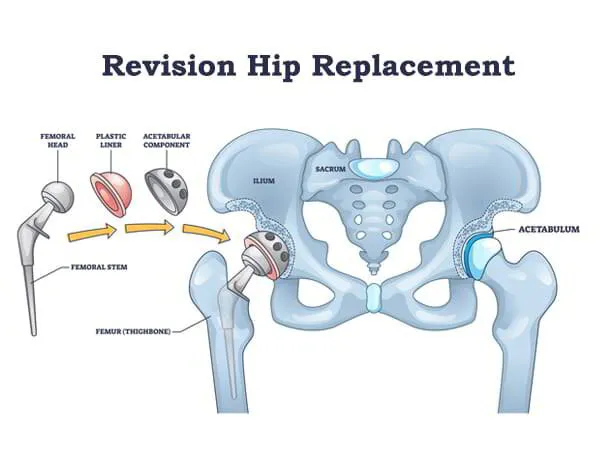Revision Hip Replacement Surgery
Home / Area of Specialty / Hip / Revision Hip Replacement Surgery
Dr. Pradyumna R carefully evaluate your conditions and symptoms associated to your hip pain and injuries, based on the diagnostic report and scan he would suggest if so, you are a candidate for Revision Hip Replacement Surgery procedure to take out parts of your old hip replacement and put in new one, he is an highly experienced hip treatment specialist provides diagnosis as well as surgical and nonsurgical treatment options at Bangalore Orthopaedic Clinic, in BTM Layout, Bangalore.
If you have any queries or would like to schedule an appointment for Revision Hip Replacement Surgery procedure or hip pain treatment consultation please call +919113025188.
What is Revision Hip Replacement Surgery?
A Revision Hip Replacement surgery is performed as an additional replacement of the artificial hip, usually because of the failure of your previous hip replacement i.e to take out parts of your old artificial hip and put in new one. This procedure can be more demanding than primary replacements because of their complexity associated with complications and lengthier recovery times. The surgery may involve the removal of all the initial implants or a few components of it and the replacement of those parts. It is a highly variable operation as it depends on the problem causing the failure of the original implant. Donor bone or artificial bone graft may also be used in this surgery.
What are the reasons to go for Revision Hip Replacement Surgery?
Usually, the reasons to undergo revision hip replacement surgeries are very clear and obvious symptoms, but not always. Some of the main reasons and noticeable symptoms are enlisted below.
- Hip pain: A primary reason.
- Plastic (polyethylene) wear: It is one of the easier revisions as only the plastic insert needs to be changed.
- Dislocation (instability of hip)
- Loosening of the femoral or acetabular component.
- Infection/ discomfort/ acute fever/ Generally feeling unwell.
- Osteolysis
- Aching and irritation due to the artificial implants
Tests and Diagnosis for Revision Hip Replacement Surgery
Your physician will conduct all the routine blood tests to rule out infection, and your surgeon may ask for CT/MRI scan to look closer at the anatomy, and bone scans to help in determining the loose components. Aspiration of the joint is rarely done to diagnose or rule out infection.
Revision Hip Replacement Surgical Procedure
A revision hip replacement is the removal of one or both parts, such as the cup in the acetabulum and/or the stem in the femur of an earlier inserted total hip replacement and inserting a new replacement. This is normally done for loosening the components or to control the infection in the old hip replacement. Delay in revision surgery can damage, deteriorate, and cause infection in the surrounding bone along with loose hip components.
Revision of an infected hip replacement may be carried out in 2 stages. As a first step, your surgeon will remove the infected hip fragments and other infected tissue. Depending on the nature of the infection you will require a course of antibiotics before the second stage operation. Patient mobility between the 2 stages is limited and the use of walking aids will be compulsory.
The duration and recovery process are entirely dependent on the type of the revision surgery, its complexity, and the patients’ health condition. Several precautions need to be followed as per your surgeons’ suggestions.
Post-operative care after Revision Hip Replacement Surgery
Post-operative care is very crucial for a healthy and quick recovery. The revision surgeries are often more complicated and prolonged than the primary surgeries. Some of the post-operative pathways usually include:
- Regular monitoring of the patient
- Pain management in a multi-modal style
- Drugs are administered to avoid blood clots, infections, and bleeding
- Urinary catheters may stay for 1-2 days
- Patients may stay 3-5 days in the acute care ward
- Patients will be given specific instructions regarding exercises and activities.
- Leg swelling is common after a hip surgery. Ice and elevation of the leg are recommended to minimize swelling and pain.
- Foot or calf pumps, early mobilizing, and hydration is necessary to prevent calf and lung clots
- If progress is slow, a referred rehabilitation will be necessary
- Eating a healthy diet and not smoking will promote healing
After undergoing revision total hip replacement, patients must take care to prevent the new joint from dislocating and ensure proper tissue and bone healing. Some of the precautions to be taken for the first 6 weeks include:
- Using an elevated toilet seat
- Avoiding sitting on low chairs
- Avoiding bending down to pick up things
- Protected weight bearing with crutches or a walking frame
- Avoiding combined movement of bending the hip and rotating the leg.
- Never crossing the legs and bending the hips past a right angle (90°)
What are the risks & complication of Revision Hip Surgery?
The risks and complications of revision hip replacement are similar to your first-time replacement. However, the risk of complications can be significantly higher due to the intricacy of the surgery.
Some of the specific complications may include:
- Thrombosis – Due to prolonged revision surgery, condition of the soft tissues and bone are at a higher risk of thrombosis. Patients may not be as mobile as patients having first-time surgery, which can contribute to the risk of blood clot formation.
- Infection - This is one of the serious complications.
- Change in the length of the leg
- Dislocation - The risk of dislocation is higher than after primary surgery.
- Nerve injury
- Fracture of the thigh bone.
- Loosening of the artificial hip.
- Bone forming in muscles around the hip (ectopic bone)
- Fracture of the femur
- Bleeding complications
- Anesthetic and general complications
- Wound Irritation
- Failure to relieve pain

